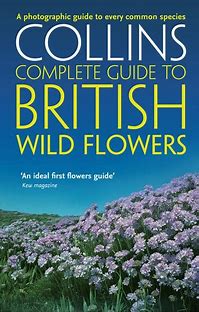
With over 1,000 main entries covering wildflowers, shrubs, aquatic plants, grasses, sedges and rushes Collins Complete Guide to British Wild Flowers is a definitive photographic reference guide for flower enthusiasts.
Helpful information about habitats of wild flowers and useful tips to aid identification are included along with a botanical hotspots section detailing 100 rarer species. Comparison pages show different leaf shapes and flower clusters to enable quick and easy navigation to the right section of the book to make your identification. This is a great book to get you started. Not overly technical and for the most part will provide you with a successful identification. Warning. We also have the Kindle version, which is horrible. Inlike the printed version, there are only a few entries on a single page and the images are useless. Go for the printed copy.

Featuring all flowering plants, including trees and grasses, and ferns, this fully revised and updated field guide to the wild flowers of Britain and northern Europe.
Leading botanical artists have been specially commissioned to ensure accurate, detailed illustrations. Species are described and illustrated on the same page, with up-to-date authoritative text aiding identification. Plants are arranged by family, with their key features highlighted for quick and easy reference. The text offers a complete account of over 1,900 wild flowers of Britain and Ireland, along with a summary of their European distribution.
This one lies between these two other books when it comes to usefulness. More technical the the book above, but not over the top like the Wildflower key below.

Revised and expanded edition of this essential guide with full keys to more than 1600 wild plants found in Britain and Ireland.
This expanded edition is packed with extra identification tips, innovative features designed to assist beginners and many more illustrations. The text aims to be as useful as possible for those working in conservation by, for example, marking plants as protected or as ‘Red List’ endangered species, and including a compilation of the latest research on ancient woodland indicator plants. The text also includes the most up-to-date keys for certain plant groups, written especially for this book. We found this book highly technical and quite hard to grasp unless you are familiar with the taxonomy of plants, but it’s probably the standard work on the subject, so is worth persevering with